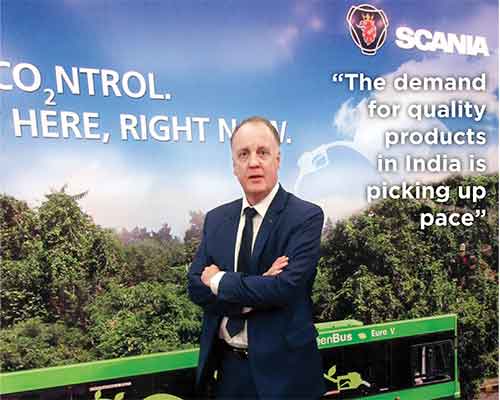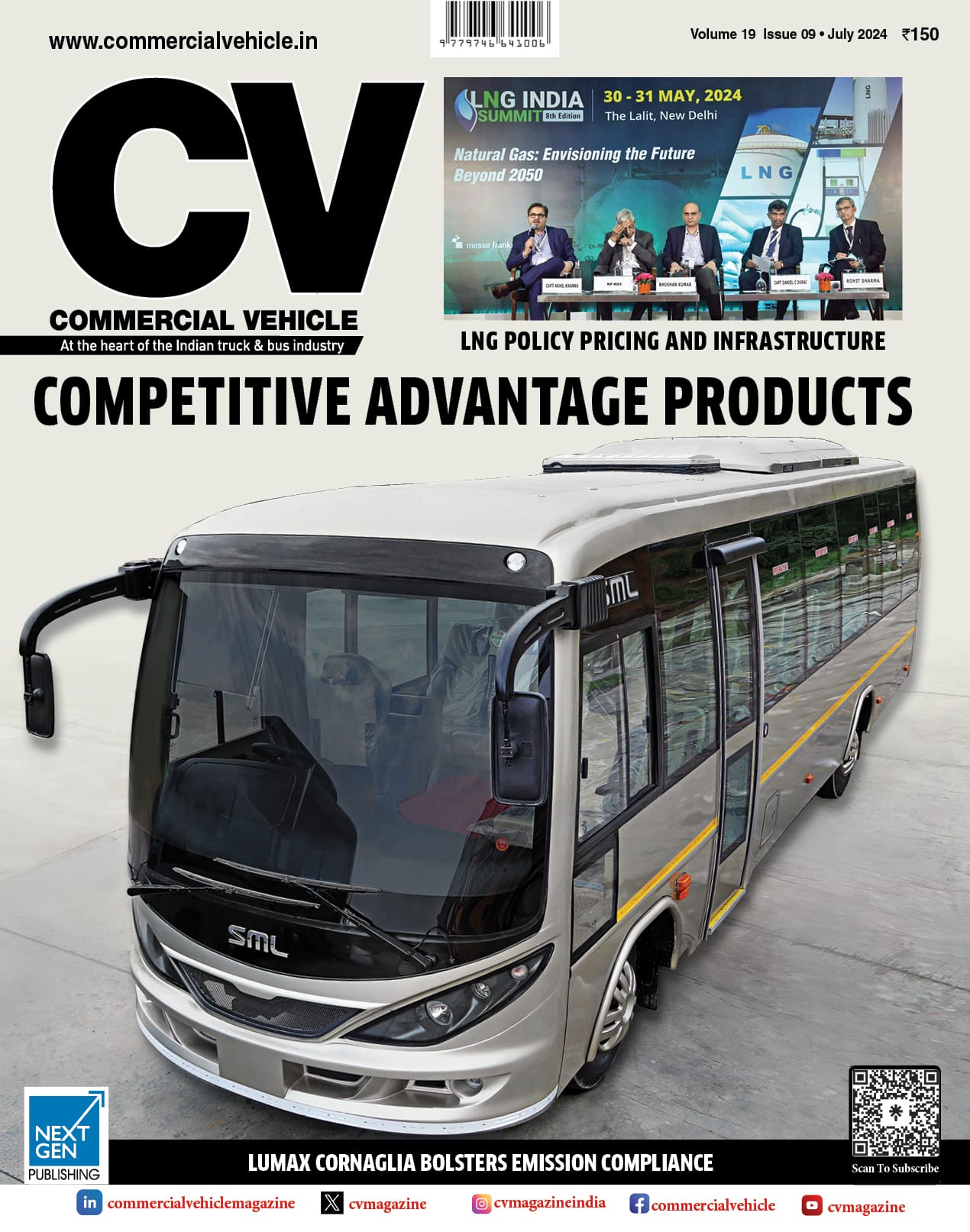 Q & A
Q & A
Mikael Benje, Managing Director, Commercial Operations,
Scania Commercial Vehicles India Pvt. Ltd.
Interview by: Anirudh Raheja
Q. How do you look at the Indian market now that you have moved from Indonesia to India?
A. Anders Grundstormer, Ex MD may be moving back to Sweden, he has however set the stage for Scania. He has set high standards. Taking over from Anders, I will be responsible for the business unit as we call it. We will be participating in the journey of renewable fuels with more thrust on reaching different states. We already have people all across the the country. They are in dialogue with different states regarding what should they focus on; what can they introduce, and can implement to their part for the environment. We will then try to understand as a company what we could offer before implementing different projects. Once we are done with that, we would have a clear roadmap for the country with respect to demands from different states, and move forward quickly. One of our important milestones is the start of green bus in Nagpur in August 2014. Our 55 buses are already plying on the roads of Nagpur. We wanted to show that buses can run on waste which might be a household waste, agricultural waste or sludge. We have done that.
Q. How does India fare in terms of a CV market rather than just a bus or a truck market?
A. The demand for quality products in India is picking up pace. We currently hold 35 per cent market share in the premium commercial vehicle space. We have already sold close to 220 Metrolink buses in India. We aim to take the number up to 400 buses this year. Market potential therefore is not a problem. We have delivered buses in Kerela, Karnataka, Tamil Nadu, Andhra Pradesh, Maharastra, Gujarat, Rajasthan, Punjab and Delhi NCR. We are also in talks with Lucknow, Mumbai, Pune and Bangalore for such buses. I am of the opinion that incentives can also prove to be a driving force for implementation of such buses running on (different) alternative fuels. For the truck segment we are working predominantly in the mining segment. We are now seeing a growth of up to 700-750 units. We also see a lot of potential in the on road segment as well. We will be targeting this segment of roughly 100 units. So overall, we are already targeting a potential of 1100 units this year.
Q. What is the current operational capacity of Narsapura plant? And how many people are employed at the plant?
A. The installed capacity of our Narsapura (near Bangalore) plant is 1000 buses. We are currently operating at 40 per cent of our capacity. Last year we rolled out 280 buses , this year we will be rolling out 400 buses. As far as the demand is concerned, we are fully ready to address it. We will not need to put much effort even if we think of doubling the capacity from our current capacity. If we decide to produce 2500 buses and 5000 trucks annually by the year 2020. Close to 850 people are already working at our bus factory, which I think is quite a quick growth. We aim to increase this number to 1,200 employees as the demand goes up.
“The demand for quality products in India is picking up pace”
Q. Scania buses are 70 per cent localished. Scania trucks are 40 per cent localised. What are the plans to reach 100 per cent localisation?
A. I think 100 per cent localisation will never be possible in India as we are not planning to develop engines here in India and would continue to import them. We are looking at some export markets that would want to buy products from India that are localised. In such a case, we will need to reduce the costs. I think, we have an year ahead of us, to really get down and increase the localisation of different materials in Scania products developed in India. I think this can go up to 45-50 per cent for the truck segment where as for the buses, we have not done so much on the chassis. We already have 80 per cent localisation in the body, which we can take to 100 per cent. We only need to find the right suppliers to match up to the Scania’s quality standards, which is a big problem. In the truck segment we have localized rims, tyres, mirrors, panels in the cabs; we have also localised axles since these are metal things. For an engine, you can break down and localise some parts of it. The engine can be built locally. All this will however take time. In the bus segment, I really see a scope to increase localisation in the bus body.
Q. OEMs are leveraging their Indian operations to source components and products for their locations the world over. What plans does Scania have?
A. I feel that we need to work on a broader perspective. India is country where there is shortage of electricity already. Whatever electricity is produced, the major chunk of it comes from burning coal. When it comes to biofuels we have always regarded ourselves a partner to India and our endeavour is to provide sustainable transport solutions. We are the only one who already has different fuel alternatives which can be implemented in different cities to reduce the emission levels. For Scania to export out of India, the prime target markets will be Asia, the Middle East and Africa . Countries like Turkey and Indonesia. However, as indicated above, we have to sort out things in the local market first. And I don’t think 2016 will be a year for exports therefore. I think, the year 2017-18 could see Scania exporting out of India. We have to be realistic. We are already running around on different projects. My priority will be to work on them, get them sorted before newer things can be thought of.
Q. What is it that you are looking at sorting out before you think of new developments like exports?
A. I think we are doing well in terms of body but we need to work more upon localisation of the chassis. If we are able to do that, we will be able to cut down costs drastically. We should also not underestimate the cost of logistics. To take a bus from our Narsapura plant to any state will involve much cost but to send it to Turkey will undertake huge logistic charges. So we need to figure out how much its costs before we can think about exports.
Q. There is a talk of GST and BS V emissions. What do you think about the two?
A. I think it is a good move by the government to introduce BS VI earlier than the set time line. There has to be a more collaborative effort which brings together policy makers and the private sector. We are already planning to introduce more green buses that can accelerate the pace of sustainable transportation in India. In the case of GST, the overall commercial vehicle sector will benefit a lot from its implementation. It will be beneficial for us in the on road segment where localisation is still at the level of 25 per cent. We have to pay an import duty of nearly 40 per cent, which is a huge burden and takes a toll on the overall cost of the truck. India is a price sensitive market and we have to address the expectations of our customers.
Trendline
When it comes to biofuels we have always regarded ourselves a partner to India and our endeavour is to provide sustainable transport solutions.



























